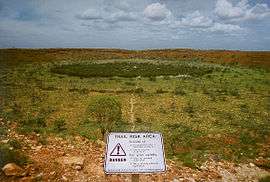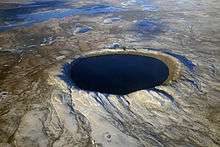Wolfe Creek Crater
Wolfe Creek Crater is a well-preserved meteorite impact crater (astrobleme) in Western Australia.[1][2]
| Kandimalal | |
 Location of the crater in Western Australia | |
| Impact crater/structure | |
|---|---|
| Confidence | Confirmed |
| Diameter | 875 m (2,871 ft) |
| Depth | 60 m (200 ft) |
| Age | ~150 ka Pleistocene |
| Exposed | Yes |
| Drilled | No |
| Bolide type | iron meteorite ~50,000 t (49,000 long tons; 55,000 short tons) |
| Location | |
| Location | Wolfe Creek Meteorite Crater National Park, Great Sandy Desert |
| Coordinates | 19°10′18″S 127°47′44″E |
| Country | Australia |
| State | Western Australia |
| Access | Tanami Road |

Description
It is accessed via the Tanami Road 150 km (93 mi) south of the town of Halls Creek. The crater is central to the Wolfe Creek Meteorite Crater National Park.[3]
The crater averages about 875 metres (2,871 ft) in diameter, 60 metres (200 ft) from rim to present crater floor.[3] It is estimated that the meteorite that formed it was about 15 metres (49 ft) in diameter and had a mass of about 17,000 tonnes; the crater is estimated to be less than 120,000 years old, placing the event in the Pleistocene.[4] Small numbers of iron meteorites have been found in the vicinity of the crater, as well as larger so-called 'shale-balls', rounded objects made of iron oxide, some weighing as much as 250 kilograms (550 lb).[5]
It was brought to the attention of scientists after being spotted during an aerial survey in 1947, investigated on the ground two months later, and reported in publication in 1949.[6] The European name for the crater comes from a nearby creek, which was in turn named after Robert Wolfe (early reports misspell the name as Wolf Creek), a prospector and storekeeper during the gold rush that established the town of Halls Creek.[7]
Aboriginal significance
The local Djaru (Jaru) Aboriginal people refer to the crater as Kandimalal.[3] There are multiple Dreaming stories about the formation of the crater. One such story describes the crater's round shape being formed by the passage of a rainbow snake out of the earth, while another snake formed the nearby Sturt Creek.[8] Another story, as told by an Elder, is that one day the crescent moon and the evening star passed very close to each other.[9] The evening star became so hot that it fell to the ground, causing an enormous explosion and flash, followed by a dust cloud. This frightened the people and a long time passed before they ventured near the crater to see what had happened. When they finally went there, they realised that this was the site where the evening star had fallen to the Earth. The Djaru people named the place "Kandimalal" and it is prominent in art from the region.[10][11]
Cultural references
The crater was featured in the 2005 horror film Wolf Creek, and the sequel in 2013, Wolf Creek 2. It also features in the Stan Australia streaming service original television series with the same name.
It was the setting for Arthur Upfield's 1962 novel The Will of the Tribe.
The Wolfe Creek crater has considerable claim to be the second most 'obvious' (i.e. relatively undeformed by erosion) meteorite crater known on Earth, after the famous Barringer Crater in Arizona.
The crater is mentioned in the 2010 children's science fiction book Alienology that says (in its universe) that a space craft crashed there.
References
- McNamara, K. Wolf Creek Crater illustrations by Ben Jackson. Perth, W.A : Western Australian Museum, 1982. ISBN 0-7244-9239-9
- "Wolfe Creek". Earth Impact Database. Planetary and Space Science Centre University of New Brunswick Fredericton. Retrieved 2006-08-06.
- "Wolfe Creek Crater National Park". NatureBase National Parks. Department of Environment and Conservation, Government of Western Australia. 2007. Archived from the original on 2007-09-29. Retrieved 2007-02-08.
- "Wolfe Creek Crater is way younger than we thought". Australia's Science Channel. 2019-11-25. Retrieved 2019-12-01.
- Bevan, Alex; Ken McNamara (1993). Australia's Meteorite Craters. Perth: Western Australian Museum. p. 8. ISBN 0-7309-5926-0.
- Reeves F. & Chalmers R.O. (1949) 'The Wolf Creek crater', The Australian Journal of Science 11, 154-156.
- "Wolf Creek Crater, Koongee Park - Alice Springs Rd, Halls Creek, WA (Place ID 10162)". Australian Heritage Database. Department of the Environment. Retrieved 2007-02-08.
- Mountford, C.P. (1976) 'Nomads of the Australian Desert', Rigby, Ltd., Adelaide.
- Goldsmith, J. (2000), 'Cosmic impacts in the Kimberly', Landscope Magazine, Vol. 15(3), pp. 28-34
- Sanday, P.R. (2007) 'Aboriginal Paintings of the Wolfe Creek Crater: Track of the Rainbow Serpent', University of Pennsylvania Press.
- Hamacher, D.W. & Norris, R.P. (2009) 'Australian Aboriginal Geomythology: Eyewitness Accounts of Cosmic Impacts?' Archaeoastronomy, Vol. 22, pp. 62-95.
Further reading
| Wikimedia Commons has media related to Wolfe Creek Meteorite Crater National Park. |
- Beasley, A. W., Wolf Creek [sic], Australia's largest meteorite crater. Victorian Naturalist, v. 87, pp. 189–191. 1970
- Cassidy, W. A., Descriptions and topographic maps of the Wolf Creek [sic] and Boxhole craters, Australia (abstract). French, B.M. and Short, N.M., eds., Shock Metamorphism of Natural Materials, Mono Book Corp., Baltimore, MD, p. 623. 1968
- Cassidy, W. A., The Wolf Creek [sic], Western Australia, meteorite crater. Meteoritics, v. 1, pp. 197–199. 1954
- Fudali, R. F., Gravity investigation of Wolf Creek crater [sic], Western Australia. Journal of Geology, v. 87, pp. 55–67. 1979
- Guppy, D. J., Matheson, R. S., Wolf Creek meteorite crater [sic], Western Australia. Bureau of Mineral Resources, Geology and Geophysics, Commonwealth of Australia, pp. 30–36. 1949
- Guppy, D. J., Matheson, R. S., Wolf Creek meteorite crater [sic], Western Australia. The Journal of Geology, v. 58, pp. 30–36. 1950
- Hawke, P. J., Geophysical investigation of the Wolfe Creek meteorite crater, Geological Survey of Western Australia Record 2003/10. 2003
- Knox, R.,Jr., Surviving metal in meteoritic iron oxide from the Wolf Creek, Western Australia, meteorite crater. Meteoritics, v. 3, pp. 235–238. 1967
- LaPaz, L., Meteoritic material from the Wolf Creek, Western Australia, crater (abstract). Meteoritics, v. 1, pp. 200–203. 1954
- Leonard, F. C., Further evidence concerning the Wolf Creek, Western Australia, crater (-1278, 192). Popular Astronomy, v. 57, pp. 405–406. 1949
- Leonard, F. C., Is the crater of Wolf Creek, Western Australia (-1278,193) meteoritic? Popular Astronomy, v. 57, pp. 138–140. 1949
- Leonard, F. C., More about the Wolf Creek, Western Australia, crater. Popular Astronomy, v. 57, pp. 345–346. 1949
- McCall, G. J. H., Possible meteorite craters - Wolf Creek, Australia and analogs. New York Academy of Sciences Annals, v. 123, pp. 970–998. 1965
- Miura, Y., New shocked quartz with high density from Wolf Creek impact crater (abstract), Meteoritics, v. 30, p. 551. 1995
- O'Neill, C., Heine, C., Glikson, A. Y., Haines, P. W., Reconstructing the Wolfe Creek meteorite impact; deep structure of the crater and effects on target rock. Australian Journal of Earth Sciences, vol 52, pp. 699–709. 2005
- Taylor, S. R., The Wolf Creek iron meteorite. Nature, v. 208, pp. 944–945. 1965
- Wooler, M. J., Johnson, B. J. , Wilkie, A. and Fogel, M. L., Stable isotope characteristics across narrow savanna/woodland ecotones in Wolfe Creek Meteorite Crater, Western Australia. Oecologia, Vol. 145, P. 100- 112. 2005

